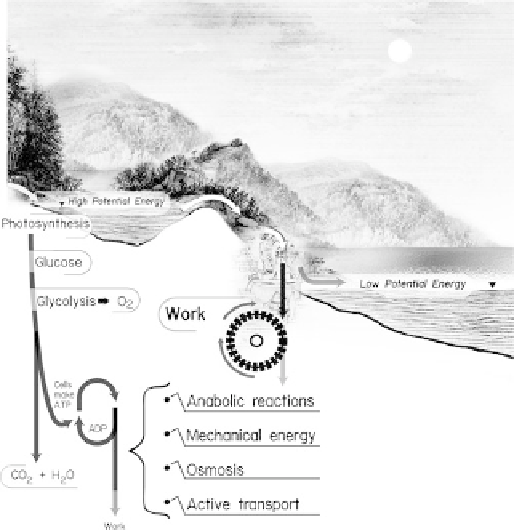Environmental Engineering Reference
In-Depth Information
such that the energy-containing compounds ATP and
NADPH are formed (Fig.
11.2
). The light-harvesting
compounds include proteins called phytochromes, but
these compounds do not act the same way as chlorophyll.
Attached to these proteins is a molecule of chromophore.
Together, they absorb photons of light energy. This absorp-
tion is translated to other parts of the plant, which can lead to
longer stems in shaded areas and shorter stems when
afforded ample light. Other such compounds include
phototropins, and their role is to help the plant position its
leaves to follow the sun.
The chemical energy stored in ATP and NADPH from the
light reaction is used to drive the reduction of CO
2
and pro-
duction of sugar, and this reduction is called the dark reaction
The production of two molecules of pyruvate, however,
represents an incomplete oxidation of the original glucose
synthesized by the plant. Aerobic organisms can obtain
additional energy by coupling the additional oxidation of
pyruvate to the reduction of the terminal electron acceptor of
molecular oxygen. Pyruvic acid then is converted in the cell
mitochondria in the
presence
of oxygen into acetyl-CoA
(Fig.
11.2
) and CO
2
by most aerobic organisms as part of
the tricarboxylic acid (TCA) or Krebs cycle. The acetyl-CoA
is then completely oxidized to CO
2
and water.
In the TCA cycle, acetyl-CoA is cycled through four
oxidative steps where electrons are released to do work as
they are passed down a redox gradient. Each of the four
oxidative steps starts with isocitrate, alpha-ketoglutarate,
succinate, and malate, and each oxidation results in the
production of two electrons and two hydrogen atoms
(Fig.
11.2
). The electrons are passed to oxygen, almost as
water is transported down a hill but through a series of
waterfalls where work is done (Fig.
11.3
). It is this electron
transfer that drives the production of ATP from ADP and P,
which in essence is the reverse, or uphill, process.
What is the source of oxygen in the TCA cycle (Figs.
11.2
and
11.4
)? Is the oxygen in gas or dissolved form? For
CO
2
þ
ATP
þ
NADPH
þ
H
!
CH
2
O
þ
ADP
þ
P
i
þ
NADP
(11.4)
The enzyme that causes this reduction is ribulose 1,5-
biphosphate carboxylase/oxygenase, or rubisco, and the pro-
cess is termed the Calvin Cycle.
Now that sugars are formed the plant cells have an avail-
able, but still untapped, source of energy. To release this
energy to do work or for growth, the sugars are oxidized,
through respiration (Fig.
11.2
), back to CO
2
and H
2
Oas
C
6
H
12
O
6
þ
8O
2
!
6CO
2
þ
12H
2
O and 686 kcal
(11.5)
Not all of the 686 kcal released is available to do work,
because some is lost as heat, much like that removed by a
radiator from a running engine or the heat felt rising from a
light bulb. The remaining energy is either used directly to
perform work or is captured and stored as an intermediate
compound such as ADP.
The first major step of respiration is glycolysis
(Fig.
11.2
). This step leads to the conversion of the 6-carbon
sugar molecules formed during the dark reaction into two
molecules of the 3-carbon pyruvic acid, or pyruvate. These
reactions occur in the
absence
of oxygen in the cell cyto-
plasm, or cytosol, of respiring cells. The sugar is first reacted
with phosphate (PO
4
) using energy from ATP to create
glucose-6-phosphate by
Glucose
þ
2PO
4
þ
2ADP
þ
2NAD
!
2 pyruvate
þ
2NADH
þ
2CO
2
þ
2 ATP (11.6)
Fig. 11.3
A representation of the similarity between the flow of
energy through a plant to do work and the flow of water harnessed to
do work. Once the reduction of CO
2
in the plant has occurred, the
potential energy of this CH
2
O is high, much as water at the top of a
water fall has high potential energy because of its elevation. This is
only true if the water is allowed to flow over the fall rather than remain
static. Once over the fall, the flowing water can be used to do work. In a
similar manner, the potential energy stored by plants in chemical bonds
in glucose also can do work for the plants during a chemical reaction.
This continues to fructose 6-phosphate, then by energy
from ATP to fructose 1,6-biphosphate, then to two 3-carbon
fragments called dihydroxyacetone phosphate and glyceral-
dehyde 3-phosphate. These are further broken down into two
molecules of pyruvate per molecule of sugar undergoing
respiration. The most common form of glycolysis is called
the Embden-Meyerhof-Parnas (EMP) pathway.


Search WWH ::

Custom Search